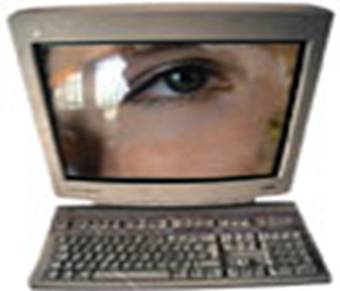Modern
technology, in
us life.
Are Computers and Television Harmful
for Your Child's Eyes?
Parents often ask me if watching television, working on the computer, or playing video games, is harmful for their child's eyes.
Doctors and teachers find that children today are less visually ready for reading than previous generations because a larger percentage of their play is passive. Activities such as watching TV, or playing video games provide less opportunity for development of visual motor skills.
Excessive viewing of TV or video games may contribute to myopia because the eye muscles become "stressed" from tightly focusing at a close distance for a prolonged period. The eye muscles are unable to fully relax, which is necessary to focus on objects that are farther away. This occurs more often if there is a genetic predisposition for myopia or nearsightedness. Another drawbac k of viewing a 2-dimensional TV screen is that it does not provide opportunities for development of depth perception or eye-hand coordination. The limited viewing area of a TV or computer screen also does not allow your child to utilize the full range of eye movements for development of tracking skills.
k of viewing a 2-dimensional TV screen is that it does not provide opportunities for development of depth perception or eye-hand coordination. The limited viewing area of a TV or computer screen also does not allow your child to utilize the full range of eye movements for development of tracking skills.
Your child's visual-motor skills are learned and developed in the same manner as walking and talking. Playing in 3-dimensional space allows the eyes to learn to change focus from far to near like a zoom camera, to develop tracking and eye teaming skills, and to perceive depth.
Play activities that promote development of visual-motor skills include: playing ball, jacks, jump rope, marbles, balloon bouncing, blowing bubbles, and hop scotch. This kind of play helps develop visual motor skills that prepare your child for the visual demands of reading.
Encouraging active play using the eyes, hands, and body in space will help your child develop visual motor skills that they need in the classroom and on the playground.
Computer can get Carpal Tunnel Syndrome, and neck and back strains can occur with excessive computer use.
Carpal Tunnel Syndrome, and neck and back strains can occur with excessive computer use.
It seems that almost every aspect of our lives today involves the use of computers. It is for this reason that Repetitive Strain Injuries, or RSIs, as they are more commonly referred to, have become more prevalent. Most of the commonly encountered types of these soft tissue injuries are Carpel Tunnel Syndrome and Tendonitis. However, RSIs can also appear in the form of neck, shoulder, and back problems. Computer use for more than a few hours on a daily basis, can easily increase the risk of these injuries. Additionally, light-touch keyboards that permit high speed typing, and constant mouse and trackball use, greatly damages affected tendons, nerves, and tissues in the hands over a period of time.
In the early stages of this condition, fatigue, numbness, and a general discomfort of the affected area are felt. Tingling, coldness, or numbness in the hands may also be present. You may also feel clumsiness, or a loss of strength and coordination in your hands. There may be pain that awakens you at night, and a constant need to massage the affected area. These symptoms usually occur only after prolonged activity and dissipate when the activity is ended. However, over time, the area becomes more sensitive and easily damaged, and even unrelated activities may cause pain. If left untreated, the pain soon becomes severe and debilitating.
It is important that you immediately consult your health care provider if you are exhibiting any of these symptoms. Immediate treatment is crucial to reduce your chances of any permanent damage. Depending on the areas affected, treatment of RSIs can include combinations of therapy, adjustments, and wrist/arm splints. In more severe cases, surgery may be recommended. The extent of the injury, and how best to treat it, can greatly vary from one patient to another.
There are many steps you can take to prevent the occurrence of RSIs. A first step is to place the computer monitor in a position that is lower and further away from you. Your chair and keyboard should be placed so that your thighs and forearms are level (or sloping slightly down away from the body). If the table’s height prohibits this, it may be necessary to place the keyboard in your lap.
Make sure to sit straight, and avoid slouching. You should not have to stretch forward to reach the keys or read what is on the screen. Be sure to move around and frequently shift your position. Arise from your seat and move around every 30 minutes.
A common mistake we often make is ignoring seating posture and positioning, especially in the wrists and back. Your wrists should not be resting on anything while typing, or be bent up or down, or to the side. Wrist rests are designed to only place your hands when pausing from typing. Do not pound on the keyboard, rather, use a light touch.
Another keyboarding error often ignored is when using key commands, such as 'CTRL-F' or 'ALT-C'. You may be tempted to use one hand and strain to reach the second key. Prolonged use in this manner can easily result in hand and finger strains. Make certain you use both hands, rather than twisting one hand when completing these type of functions.
To prevent back strain problems, sit up straight in your seat. If necessary use a lumbar support pillow to help maintain proper posture. Be aware of any stresses that may naturally be causing you to slump or pull your shoulders upward. Correct this by periodically checking your posture and adjusting it accordingly.
Use the appropriate font size on your screen to prevent hunching your shoulders forward to read. Many desktop applications can be easily customized to use larger, easier to read fonts. Also, experiment with color schemes that are easier on your eyes, such as shades of gray for text documents.
Placing your mouse or trackball device in close proximity to your keyboard can also avoid shoulder and neck strains.
Avoid constant gripping or squeezing of the mouse.
Excessive recreational computer use, such as video games are known culprits of RSIs. When playing video games for an extended period of time, take stretching breaks every few minutes.
Increased strength and flexibility can decrease muscle fatigue. Create and follow through with a balanced exercise program, such as walking on a daily basis.
Relax in a warm bath or shower at the end of a long work day. Lastly, and more importantly, heed any signs of discomfort and note awkward movements before they lead to RSI.
Your children may also be at risk for computer related RSIs, due to their small stature. Be sure to review these guidelines with your children so that they can also make the necessary adjustments.
Harmful effects of Television.
Most people think that television is Haraam only because it projects images of living creatures. Today, tables in living rooms and bedroom walls are adorned and decorated with family pictures and other portraits, to the extent that some students hang the portraits of their shaikh on the wall for blessings. It is difficult to comprehend how the mercy of Allah ta’alaa is going to descend.
Any home that has a video and television is not visited by angels. The Holy Prophet of Allah (S.A.W.S) has informed us that any home which contains pictures of living creatures is not visited by angels. However, do you think television is only haraam because it projects images? There are many reasons for the ‘T.V.’ being haraam. Everybody who studies its influences finds new dangers. Televsion is an instrument of violating the injunction of hijaab. We all know that a non-mahram man cannot look at a non-mahram woman. The Prophet (S.A.W.S) has said “verily, the gaze is a poisonous arrow from the arrows of satan”.
Take heed my friends! After having seen one woman you turn to another and then another and are not satisfied and so you move onto magazines. But, the lust in your heart remains unfulfilled so you move onto pornographic images on the television and video.  The truth is always bitter and hard, but one does not need to conduct a survey to find out what people think when they are spending hours, watching naked women and men on the filthy ‘box’. The viewing of films that inflame sexual desires is definitely questionable. It is reported on the authority of Hasan Basri (R.A) that the Apostle of Allah (S.A.W.S) is to have said “the curse of Allah is on the who sees and on the one who is seen”. When a man looks at a non-mahram woman, then Allah’s curse descends on that individual for as long as he keeps on looking. We are glued to the television for 2 to 3 hours, some even more, at a time. Be cautioned my friends. During all this time, Allah’s curse is befalling us.
The truth is always bitter and hard, but one does not need to conduct a survey to find out what people think when they are spending hours, watching naked women and men on the filthy ‘box’. The viewing of films that inflame sexual desires is definitely questionable. It is reported on the authority of Hasan Basri (R.A) that the Apostle of Allah (S.A.W.S) is to have said “the curse of Allah is on the who sees and on the one who is seen”. When a man looks at a non-mahram woman, then Allah’s curse descends on that individual for as long as he keeps on looking. We are glued to the television for 2 to 3 hours, some even more, at a time. Be cautioned my friends. During all this time, Allah’s curse is befalling us.
There is no doubt that society at large influences children, but without any hesitation I can say that the effects the television has are far greater. It is the television that take our children on the path of drugs, alcohol, fornication, disrespect, confrontation, modernism and many other evils that are apparent in our society today. Know that these evils are a direct result of watching and learning from the television.
Infact, television is being used to disseminate evil within the community. You may think that you are passing time and entertaining yourself when you are passing several hours in front of the T.V. You are mistaken my friend! The television is not an instrument of entertainment, but an instrument used to reshape and motivate ones thoughts and loyalties. Whatever you watch on television you accept as the truth. If the television was to announce that Afghanistan was captured by the USA, no-one would doubt it.
Magnetic Fields harmful.
Prolonged exposure to low-level magnetic fields, similar to those emitted by such common household devices as blow dryers, electric blankets and razors, can damage brain cell DNA, according to researchers in the University of Washington's Department of Bioengineering. The scientists further found that the damage from brief exposures appears to build up over time.
The new study is scheduled to be published in Environmental Health Perspectives, a journal of the National Institutes of Environmental Health Sciences, and is available now on the Internet.
In the study, the researchers discovered that rats exposed to a 60-hertz field for 24 hours showed significant DNA damage, and rats exposed for 48 hours showed even more breaks in brain cell DNA strands. Exposure also resulted in a marked increase in brain cell apoptosis, or "cell suicide," a process in which a cell self-destructs because it can't repair itself.
A previous study showed similar damage, but it was conducted at 10 times the intensity and rats were exposed for just two hours. That indicates that the effects of exposure are cumulative, and duration can be as damaging as intensity, said Henry Lai, a UW research professor who conducted the study with fellow UW bioengineer Narendra Singh. "In real life, people get this kind of exposure in brief doses – three minutes of exposure to a blow dryer , five minutes of exposure to an electric razor," Lai said. "We found that this could add up over time and could eventually lead to some health effect." Since Lai first reported findings of magnetic field-induced DNA damage in 1995, several laboratories in Europe and India have reported similar effects.
, five minutes of exposure to an electric razor," Lai said. "We found that this could add up over time and could eventually lead to some health effect." Since Lai first reported findings of magnetic field-induced DNA damage in 1995, several laboratories in Europe and India have reported similar effects.
Traditionally, scientists have held that low-level electromagnetic fields couldn't be harmful because they weren't potent enough to break chemical bonds in a living organism. Lai doesn't disagree – he simply suspects a more subtle mechanism is at work. He believes that the fields, rather than causing harm directly, initiate a process within the cells that leads to the damage.
Lai and Singh hypothesize that exposure to magnetic fields affects the balance of iron in certain cells, leading to an increase in free iron within the cell. That free iron undergoes a chemical reaction, which releases "free radicals," or charged atoms that attack cell structures, including DNA, lipids and proteins.
To test the idea, the researchers gave some of the rats drugs that either neutralize free radicals or decrease free iron before exposing the animals to the magnetic field. The treatments supported the hypothesis, effectively blocking the effects of the fields and protecting the rats' brain cell DNA from damage.
One significant implication of this is that certain types of cells with higher iron content – such as brain cells – may be more susceptible to damage from electromagnetic fields.










 k of viewing a 2-dimensional TV screen is that it does not provide opportunities for development of depth perception or eye-hand coordination. The limited viewing area of a TV or computer screen also does not allow your child to utilize the full range of eye movements for development of tracking skills.
k of viewing a 2-dimensional TV screen is that it does not provide opportunities for development of depth perception or eye-hand coordination. The limited viewing area of a TV or computer screen also does not allow your child to utilize the full range of eye movements for development of tracking skills.
 The truth is always bitter and hard, but one does not need to conduct a survey to find out what people think when they are spending hours, watching naked women and men on the filthy ‘box’. The viewing of films that inflame sexual desires is definitely questionable. It is reported on the authority of Hasan Basri (R.A) that the Apostle of Allah (S.A.W.S) is to have said “the curse of Allah is on the who sees and on the one who is seen”. When a man looks at a non-mahram woman, then Allah’s curse descends on that individual for as long as he keeps on looking. We are glued to the television for 2 to 3 hours, some even more, at a time. Be cautioned my friends. During all this time, Allah’s curse is befalling us.
The truth is always bitter and hard, but one does not need to conduct a survey to find out what people think when they are spending hours, watching naked women and men on the filthy ‘box’. The viewing of films that inflame sexual desires is definitely questionable. It is reported on the authority of Hasan Basri (R.A) that the Apostle of Allah (S.A.W.S) is to have said “the curse of Allah is on the who sees and on the one who is seen”. When a man looks at a non-mahram woman, then Allah’s curse descends on that individual for as long as he keeps on looking. We are glued to the television for 2 to 3 hours, some even more, at a time. Be cautioned my friends. During all this time, Allah’s curse is befalling us.
 , five minutes of exposure to an electric razor," Lai said. "We found that this could add up over time and could eventually lead to some health effect." Since Lai first reported findings of magnetic field-induced DNA damage in 1995, several laboratories in Europe and India have reported similar effects.
, five minutes of exposure to an electric razor," Lai said. "We found that this could add up over time and could eventually lead to some health effect." Since Lai first reported findings of magnetic field-induced DNA damage in 1995, several laboratories in Europe and India have reported similar effects.  Findings on the thermal effect of acute exposure to radiofrequency fields were consistent, resulting in an increase of cellular, tissue or body temperature by 1 degree C or more. Guidelines for risk limits are based on this thermal effect.
Findings on the thermal effect of acute exposure to radiofrequency fields were consistent, resulting in an increase of cellular, tissue or body temperature by 1 degree C or more. Guidelines for risk limits are based on this thermal effect.  To heat up something big like a turkey breast, the heat has to diffuse from the surface to the inside. Plan on putting at least a few minutes on the timer.
To heat up something big like a turkey breast, the heat has to diffuse from the surface to the inside. Plan on putting at least a few minutes on the timer.